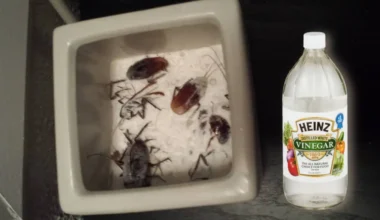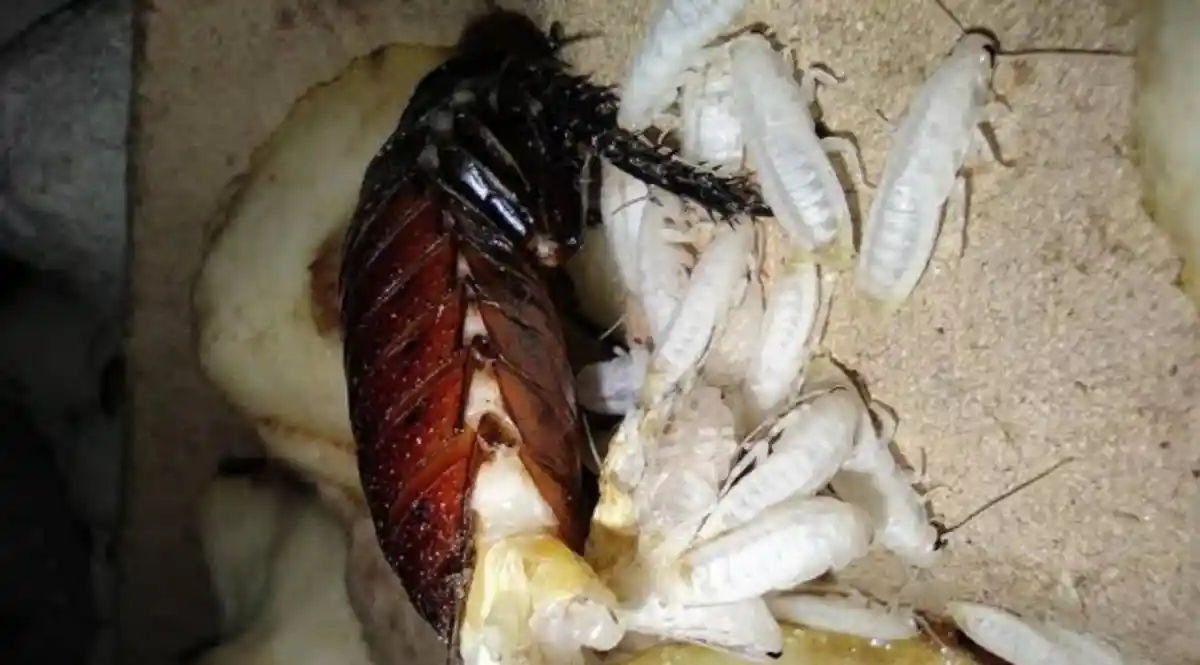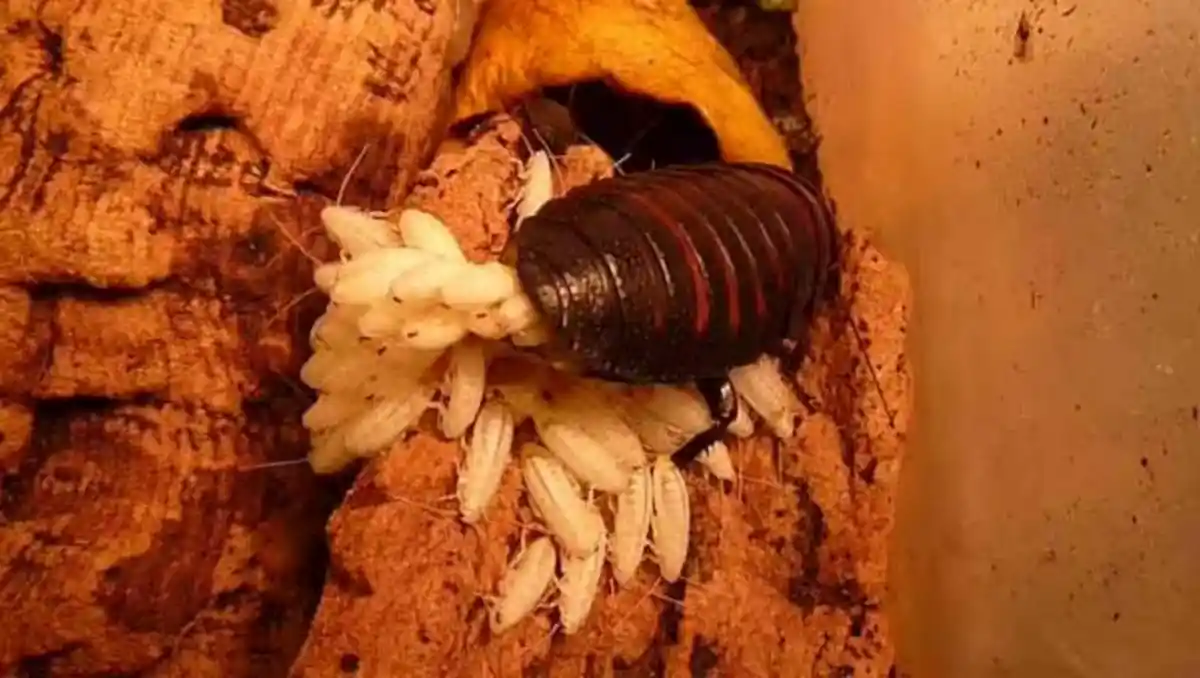You spotted a disgusting roach scampering across your floor or surface. I know that feeling, roaches make us irk. But not to worry, this post explains how to lure a cockroach out of hiding if you lost it. It helps to get rid of that one cockroach early to avoid potential infestation. Besides, roaches are insects that breed aggressively.
How to lure a cockroach out of hiding

It can be tricky to get a roach to come out but not impossible. Follow the tips below to lure a cockroach out of hiding:
1. Place a scented sticky trap next to its hideout
You’re probably familiar with the traditional sticky fly paper employed for trapping flies. The adhesive in glue traps is typically effective for catching roaches.
Glue or sticky traps essentially function as adhesive surfaces that cockroaches move on, and once they make contact with the sticky adhesive, they become trapped and unable to free themselves.
For sticky a trap to be effective, add scents such as starch, sugar, grease, meat, cheese, rotting fruits, and vegetables to attract cockroaches to it to prompt them to move out of their hideouts and onto the trap. These traps are is especially effective against nymphs and baby cockroaches, as they find it even tougher to free themselves once they come into contact with the adhesive surface.
Nonetheless, fully grown roaches can break free if they become ensnared in a glue trap. Hence, if you buy glue traps, make sure to inspect them daily and replace them regularly, as the presence of deceased roaches caught in the trap can prevent others from approaching and stepping into the same trap.
2. Light up the hideout
Roaches are active at night and prefer dark and dimly lit environments. Thus, exposing their nest to a bright light source will encourage them to leave their hiding spot.
However, note that simply shining a light into the roach nest will not eradicate an infestation. A comprehensive approach, which may include the use of bait, traps, and/or insecticides, may be necessary to effectively eliminate the roaches and prevent future infestations.
3. Add poisoned food
Another method to entice cockroaches from their hiding places and enhance the effectiveness of commercial glue traps or poisoned bait is to utilize food as a supplementary lure.
Breadcrumbs or baby food can serve as effective bait to attract cockroaches out of their nests and into your traps. Peanut butter can also be used, and dipping bread in beer has been demonstrated to be a highly attractive lure for cockroaches.
4. Lure the roach out with a hairdryer
If you identified its nest, and it is readily accessible, direct a hairdryer with hot air into the nest.
The heat produced by the hairdryer is likely to provoke the roach, thus, luring it out of hiding. Moreover, the nest cannot endure the high temperature. In certain cases, this approach may even eliminate other hiding roaches.
5. Capture the roach with a jar trap
To implement this method, use a large jar, such as a jam jar, and place some bait, such as bread inside to lure a cockroach out of hiding. Smear the inside of the jar with petroleum jelly.
The roaches will be drawn in by the bait and will climb into the jar to reach it. However, the petroleum jelly on the inside walls of the jar will prevent them from escaping. Simply collect and dispose of the trapped roaches each morning.
Empty the roach jar regularly as a jar full of trapped roaches will discourage other roaches from entering. Additionally, clean the jar frequently, as the odor of dead roaches may also deter others from entering.
6. Bait a soda bottle
Another lure and trap method that operates similarly to the jar trap can be created using a plastic soda bottle.
To make this trap, take an empty two-liter soda bottle and cut off the top portion about four inches down from the rim. Spread petroleum jelly on the outside of the removed top portion. Place bait, such as bread dipped in beer, in the bottom of the bottle and insert the top portion upside down into the bottom portion.
The petroleum jelly on the outside of the top portion will now be inside the bottom section, trapping the cockroaches and preventing them from escaping. Secure the top and bottom portions of the bottle together using duct tape and place the trap in an area where cockroaches are known to be active.
Cockroaches will crawl into the opening of the bottle in search of food, but due to the petroleum jelly, they will be unable to escape. Simply check the trap every day or two to remove any trapped roaches.
7. Insecticide spray
Insecticide spray is a widely used and effective method for luring a roach out of hiding. By directly applying commercial insecticide to the roach nest, it is possible to effectively eliminate the roaches and remove them from their dwelling.
Follow the instructions on the insecticide label carefully and use appropriate personal protective equipment when handling the product. Additionally, it may be necessary to repeat the application several times to lure a cockroach out of hiding.
8. Set up duct tape trap
You can create your own glue trap using building-grade duct tape. Simply place some strips of duct tape with the adhesive side facing up in an area known to be frequented by cockroaches.
To ensure the roaches fall into your trap, attract them with bait such as peanut butter, jelly, or breadcrumbs. Check your trap daily to see how many roaches you have captured and replace the trap as needed. Keep in mind that the presence of dead roaches in the trap may deter other roaches from entering.
This method is not a long-term solution, as while it may catch a few roaches and temporarily reduce their numbers, it will not eliminate other roaches or their offspring in the nest.
9. Use poisoned roach bait
Poisoned bait is an effective way to lure a cockroach out of hiding. Also, it delivers a lethal dose to the cockroach. Additionally, they do not die instantly, roaches can carry the poison back to their nests, leading to the death of all the other roaches residing there.
There are many commercially available options, although gel bait may arguably be the most effective. The application process for gel bait is just to place it in any area where you saw a cockroach.
Cockroaches may not be visible after consuming your gel lure, as they tend to return to their nest rather than dying in the open. Nevertheless, with time, you should be able to catch the cockroach.
The gel can potentially eliminate roach infestation and save you worries about your rental insurance coverage. However, it may not be a viable option if you have pets or children in your residence.
10. Place poisoned roach cookies
An alternative lure you can use to lure a cockroach out of hiding involves preparing homemade roach cookies. To create these cookies, fashion a typical batch of cookie dough and integrate an equivalent amount of boric acid into the mixture.
After mixing the cookie dough and boric acid, there is no need to bake it. Instead, break off small sections of the dough and deposit them in locations where roaches are likely to locate them. Enticed by the alluring cookies, the roach will eat them, leading to their death due to the boric acid’s toxic properties. Replace the dough every 1-2 weeks and monitor the situation.
11. Sprinkle essential oil
Essential oils, such as tea tree oil, eucalyptus, peppermint, or lavender, are known to have a strong and unpleasant odor for cockroaches. Thus, you can use them to get rid of a cockroach you can’t find. If you soak a small cloth in one of these oils and add it to the roach nest, it can make the area less desirable to them and other pests and discourage them from residing there.
However, while this method may help to lure a cockroach out of hiding, it is not a long-term solution for controlling an infestation.
Cockroaches can quickly adapt to new environments and may eventually become immune to the scent of essential oils. Therefore, it may be necessary to try other methods, such as bait, traps, or insecticides, in conjunction with the use of essential oils to effectively eliminate the infestation.
12. Apply hot water and detergent mixture
Using a mixture of hot water and detergent to flush out the roach nest can be an effective solution, but it should be approached with caution. Pouring the mixture into the nest can cause the roaches to relocate, but it is important to be mindful of the potential for water damage to your home.
Consider the potential impact on your neighbors if you live in an apartment building. The mixture could potentially cause water damage to the unit below, so weigh the potential consequences before attempting this method.
How do I make sure roaches don’t come back?
After you’ve succeeded in luring a roach out of hiding, your next concern should be keeping them from returning. Follow the tips below to make sure roaches don’t come back:
1. Eliminate their water sources
While certain species of cockroaches can survive without food for up to a month, they can only survive for a few days without access to water.
As a result, reducing their access to water sources by fixing leaks, drying bathroom areas, and other similar measures may force them to leave their hiding place in search of water.
2. Don’t spare their food supplies
Getting rid of cockroaches begins by making your home unattractive to them. Make sure to keep all food in sealed containers, clean up any spills right away, and regularly clean your kitchen. By reducing other food sources, cockroach baits will become even more effective because the roaches will be more drawn to the bait if they have nothing else to eat.
3. Keep baiting them
Cockroaches are smart and know that they are vulnerable when they come out of hiding. To control them, it can help to use bait that makes them feel safe.
The smell of things like bread soaked in beer, peanut butter, or baby food can be very tempting to them and make them take the risk to find the source of the smell.
4. Reduce your sources of noise
To maximize the effectiveness of your roach traps, try to maintain a quieter environment after setting them up. Loud noises and excessive activity may startle the roaches and deter them from approaching the traps. A cockroach is insensitive to sound above approximately 3,000 Hz, following research Auditory thresholds in the American cockroach (Orthoptera: Blattidae): estimates using single-unit and compound-action potential recordings.
Make sure to limit the frequency of trap inspections. Over-checking the traps can increase the roaches’ wariness and decrease their likelihood of entering the traps. To ensure the best results, wait until the traps have had time to attract and trap the roaches before checking them.
5. Stay away from the trap
Keep a distance from the trap to lure a cockroach out of hiding. Regularly inspecting the trap can make the roaches more cautious and decrease the chances of them entering the trap. The solution is to limit the frequency of inspections and give the roaches ample time to approach and enter your trap.
6. Combine multiple methods
Arguably, the most effective approach is to employ a combination of the aforementioned methods and baits. Implementing a variety of these strategies improves the probability of coaxing the roaches out of their hiding places and into one of the installed traps. It is advisable to experiment with several of these concepts to determine which ones yield the most desirable outcomes.
FAQs – lure a cockroach out of hiding
Can 1 roach cause an infestation?
The answer is yes. Some female cockroaches can reproduce without mating, and it is unlikely that a single cockroach will be the only one present in your home. Cockroaches are known to reproduce rapidly and can quickly infest an area if left unchecked.
Where do roaches hide in your home?
Cockroaches look for shelter in tight cracks and holes. You can find them behind refrigerators, under sinks, and in dimly lit drawers and cabinets. At night, they go out to find food and will eat almost anything, even in clean homes.
What do roaches eat to survive?
Cockroaches are generalists when it comes to their diet, meaning they eat both plants and animals. They have a preference for starchy foods, sweets, fatty foods, and meats, but they are not choosy eaters. They will consume almost anything that was once alive, such as plants and animals.






